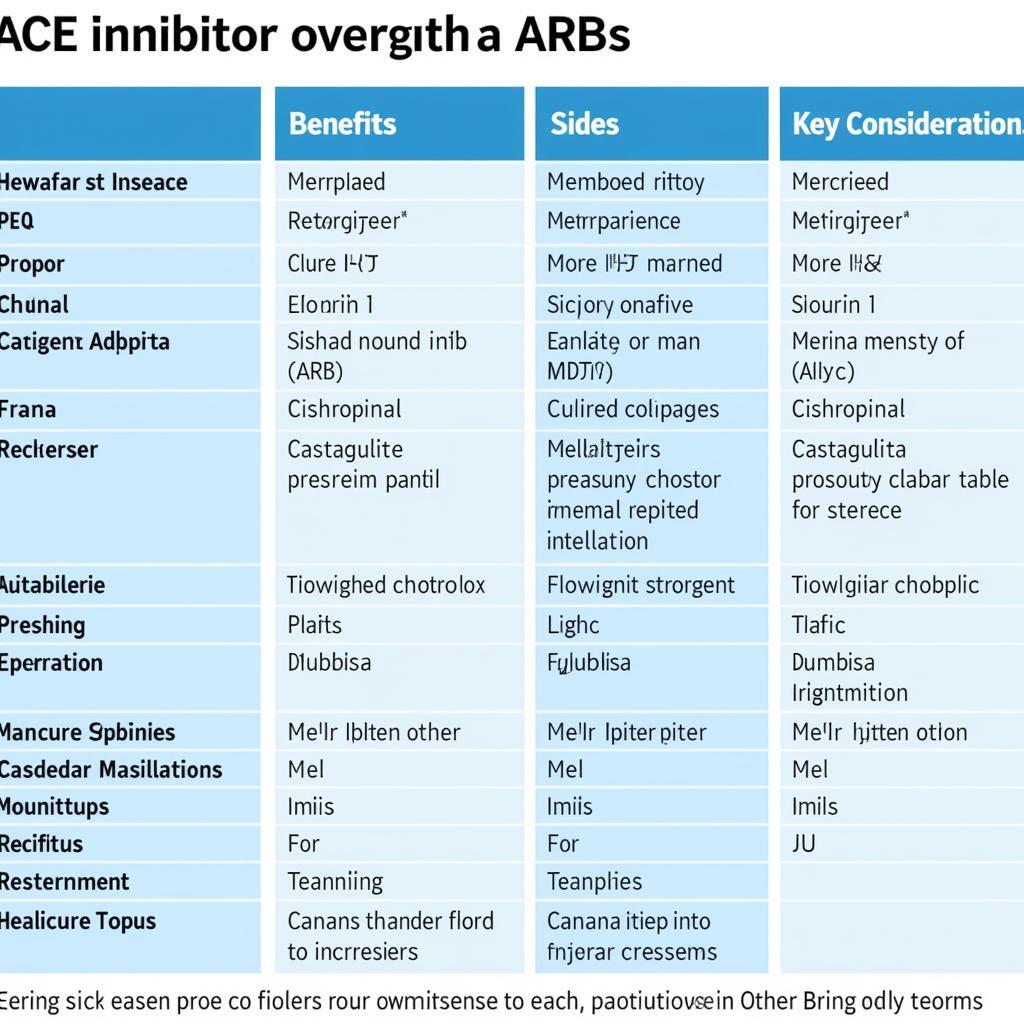Navigating the world of blood pressure medications can feel overwhelming, especially when faced with a multitude of options. Two common classes, ACE inhibitors and ARBs, are often prescribed to manage hypertension. While they share the goal of lowering blood pressure, they work in slightly different ways and offer distinct benefits and considerations. This article delves into the nuances of ACE inhibitors and ARBs, providing you with the knowledge to have an informed discussion with your healthcare provider about the best choice for your individual needs.
Deciphering the Mechanisms: How ACE Inhibitors and ARBs Tackle High Blood Pressure
Both ACE inhibitors and ARBs belong to a group known as RAS blockers. The renin-angiotensin-aldosterone system (RAAS) is a complex hormonal pathway that plays a crucial role in regulating blood pressure.
 ACE Inhibitors Mechanism of Action
ACE Inhibitors Mechanism of Action
ACE Inhibitors: Inhibiting the Enzyme
ACE inhibitors, short for angiotensin-converting enzyme inhibitors, work by blocking the action of the angiotensin-converting enzyme (ACE). ACE is responsible for converting angiotensin I to angiotensin II, a potent vasoconstrictor. By inhibiting ACE, these medications reduce the production of angiotensin II, leading to:
- Vasodilation: Relaxation of blood vessels, allowing blood to flow more easily.
- Reduced Sodium and Water Retention: Lowering blood volume, further contributing to lower blood pressure.
ARBs: Blocking the Receptor
Angiotensin II receptor blockers (ARBs), as their name suggests, block the action of angiotensin II by binding to its receptors. This prevents angiotensin II from exerting its vasoconstrictive effects. Similar to ACE inhibitors, ARBs lead to:
- Vasodilation: Widening of blood vessels, reducing resistance to blood flow.
- Reduced Aldosterone Production: Lowering aldosterone levels, a hormone that promotes sodium and water retention, further aiding in blood pressure control.
 ARBs Mechanism of Action
ARBs Mechanism of Action
Weighing the Pros and Cons: ACE Inhibitors vs. ARBs
Both ACE inhibitors and ARBs are effective in lowering blood pressure and are generally well-tolerated. However, they have distinct characteristics that might make one more suitable than the other depending on individual patient factors.
ACE Inhibitors: Benefits and Considerations
Potential Benefits:
- Proven Track Record: Long history of use with established efficacy.
- Cardioprotective Effects: May protect against heart attack, stroke, and heart failure.
- Beneficial in Diabetic Nephropathy: Slows the progression of kidney disease in individuals with diabetes.
Potential Considerations:
- Dry Cough: A common side effect due to the buildup of bradykinin.
- Angioedema: Rare but serious allergic reaction causing swelling of the face, lips, tongue, or throat.
- Not Suitable During Pregnancy: Can cause harm to the developing fetus.
ARBs: Benefits and Considerations
Potential Benefits:
- Lower Risk of Cough: Less likely to cause a dry cough compared to ACE inhibitors.
- Similar Efficacy to ACE Inhibitors: Equally effective in lowering blood pressure.
- May Offer Better Tolerability: Some individuals find ARBs easier to tolerate than ACE inhibitors.
Potential Considerations:
- Less Data on Long-Term Effects: Relatively newer class of drugs with less established long-term safety data compared to ACE inhibitors.
- Similar Contraindications: Also not suitable during pregnancy and may cause angioedema, though less frequently than ACE inhibitors.
 ACE Inhibitors vs. ARBs Comparison
ACE Inhibitors vs. ARBs Comparison
Choosing the Right Path: Collaborating with Your Healthcare Provider
The decision to prescribe an ACE inhibitor, an ARB, or another class of blood pressure medication is best made in consultation with your doctor. They will consider various factors, including:
- Your Medical History: Existing health conditions, allergies, and medications.
- Blood Pressure Goals: Target blood pressure based on your individual risk factors.
- Lifestyle Factors: Diet, exercise, and smoking status.
- Potential Side Effects: Assessing your risk for and tolerance of potential side effects.
Conclusion: A Personalized Approach to Blood Pressure Management
Managing blood pressure effectively requires a tailored approach. Understanding the differences between ACE inhibitors and ARBs empowers you to engage in meaningful conversations with your healthcare provider. By working together, you can develop a treatment plan that aligns with your health goals and optimizes your overall well-being.
Frequently Asked Questions:
1. Can I switch from an ACE inhibitor to an ARB or vice versa?
Switching between these medications is possible but should only be done under the guidance of a healthcare professional.
2. Are ACE inhibitors or ARBs safe for long-term use?
Both classes of medications are generally safe for long-term use. However, regular monitoring by your doctor is essential.
3. What should I do if I experience side effects?
Contact your doctor immediately if you experience any unusual symptoms after starting an ACE inhibitor or ARB.
4. Are there natural alternatives to ACE inhibitors and ARBs?
Lifestyle modifications like diet and exercise can help manage blood pressure but should be discussed with your doctor alongside medication.
5. Can I take ACE inhibitors and ARBs together?
Combining these medications is generally not recommended as it can increase the risk of side effects.
Need more information? Reach out to us!
For any questions or concerns about ACE inhibitors, ARBs, or other healthcare-related topics, please don’t hesitate to contact us:
Phone: 0369020373
Email: [email protected]
Address: Thon Ngoc Lien, Hiep Hoa, Bac Giang, Vietnam
Our dedicated team is available 24/7 to provide support and guidance.

